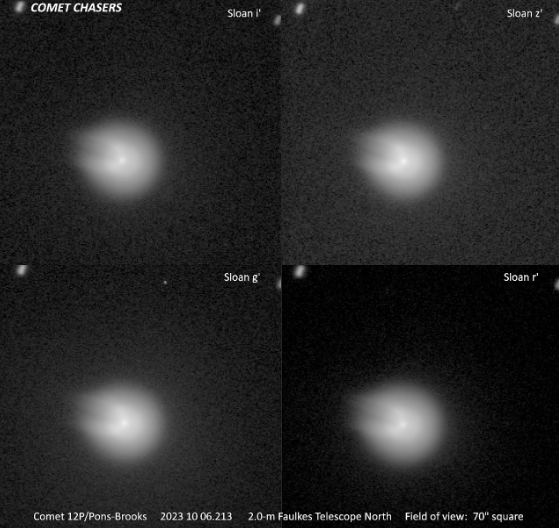The comet 12P/Pons-Brooks is known for its regular explosions where it develops an odd shape and increases sharply in brightness. After one such outburst three months ago, Pons-Brooks is brightening again, and this time it’s tens of millions of kilometers closer.
If sky-watchers are lucky, 2024 could be known as the year of the two comets. Although dozens of comets make their closest approach to Earth each year, most are too faint to see without a telescope. Two that are heading our way next year come with the possibility of putting on some of the best shows for years, although with even more uncertainty than most comet predictions.
Pons-Brooks was discovered in 1812 and identified as the same comet that had been seen in 1385 and 1457 (those visits being before we knew how to plot celestial objects’ orbits). It returned in 1884 and 1954.
On the last two visits it was seen experiencing outbursts, where its brightness increased quite rapidly as a result of icy volcanic eruptions. Unusually, these sometimes took place when the comet was still a long way from the Sun. Although a few comets undergo explosions while still in cold regions of the Solar System, most mysteriously in the case of 29P/Schwassmann-Wachmann, this sort of bursting is rare and fascinating to astronomers. The explosions are caused by pockets of internal ice warming enough to turn to gas and bursting through the surface.
Naturally plenty of attention was focused on Pons-Brooks from the first recovery on this visit and it has not disappointed. An outburst in July not only made it almost 100 times brighter, but left the comet with an odd shape that has been likened to Pac-Man or the Millennium Falcon. The shape is thought to be caused by an obstruction blocking the flow of gas that creates the “horns” on either side.
That outburst was fading when another one occurred in early October. Although this burst is not quite as large as the first one, the comet is considerably closer to the Earth now than three months ago, so it recently hit its greatest brightness so far on this visit.
A collaboration of professional and amateur astronomers known as the Comet Chasers have been tracking Pons-Brooks and produced the image above, as well as this collection.

Four images of comet Pons-Brooks taken with different filters.
Image courtesy of Comet Chasers Education and Outreach Project. Observers: Mirjana Malaric (Zagreb, Croatia) and Jose Manuel Perez Redondo (Institut d’Alcarràs, Catalonia) and their students using the Faulkes Telescope North
Most comets fall into two categories: long and short period. Long period comets journey in from the outer Solar System (or occasionally even beyond) for the first time in thousands of years and will take further millennia to return. Short period comets visit the inner Solar System frequently if they ever leave, but lose some of their ice each time. After numerous passages they are mostly small and faint.
Pons-Brooks belongs to a rare third class, known as Halley-type after its most famous member, that drop in once or twice a human lifetime. In Pons-Brooks’ case its orbit lasts 71 years, and it will make its closest approach to the Sun on April 21, 2024 and to Earth on June 2.

Comet Chaser students from the Institut d’Alcarràs measuring the change in brightness between their observations and previous ones from St Mary’s Primary School, Bridgend, UK.
Image courtesy of Helen Usher
As with all comets, particularly those that haven’t visited for a while, its brightness is hard to predict. If it follows a conventional light curve it’s expected to peak around fifth magnitude – bright enough to make out under very dark skies without instruments, but only just. However, a well-timed outburst could increase its brightness up to 100-fold, which could allow it to compete with the brightest stars in the sky.
Later in the year an even more unpredictable event will occur when Comet C/2023 A3 (Tsuchinshan-ATLAS) approaches the Sun for the first time in 80,000 years. Naturally we can’t look at records of previous passes for this one, but based on its size and current brightness, this could compete with Venus, making it the best comet for at least 17 years. Given cometary unpredictability, however, it would be a bad idea to skip Pons-Brooks in the expectation of a better show six months later that may never arrive.
Source Link: Comet Pons-Brooks Has Regrown Its “Horns”, Looks Like The Millennium Falcon Again